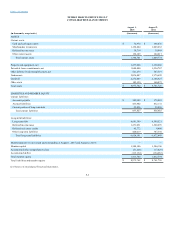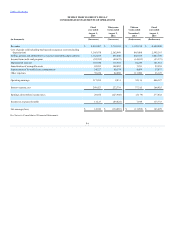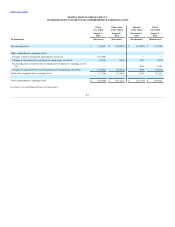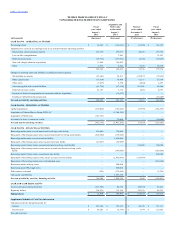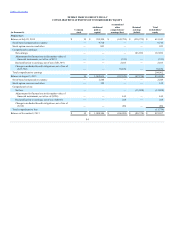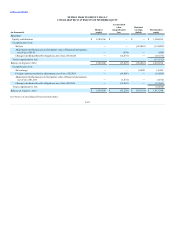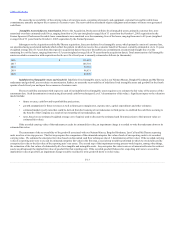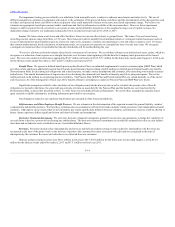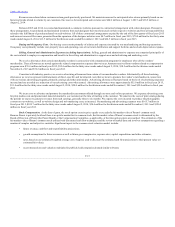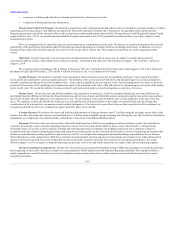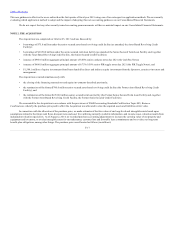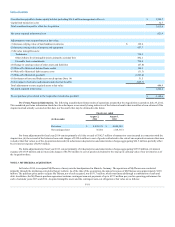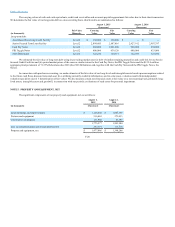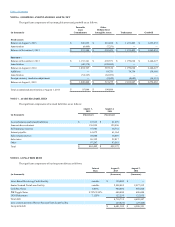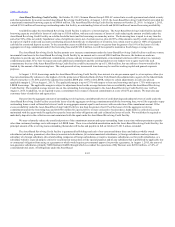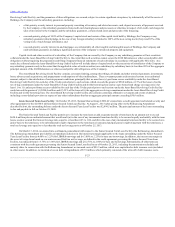Neiman Marcus 2014 Annual Report Download - page 116
Download and view the complete annual report
Please find page 116 of the 2014 Neiman Marcus annual report below. You can navigate through the pages in the report by either clicking on the pages listed below, or by using the keyword search tool below to find specific information within the annual report.
Table of Contents
The impairment testing process related to our indefinite-lived intangible assets is subject to inherent uncertainties and subjectivity. The use of
different assumptions, estimates or judgments with respect to the estimation of the projected future cash flows and the determination of the discount rate used
to reduce such projected future cash flows to their net present value could materially increase or decrease any related impairment charge. We believe our
estimates are appropriate based upon current market conditions and the best information available at the assessment date. However, future impairment
charges could be required if we do not achieve our current revenue and profitability projections or the weighted average cost of capital increases. No
impairment charges related to our tradenames and goodwill were recorded in fiscal years 2015, 2014 or 2013.
Leases. We lease certain retail stores and office facilities. Stores we own are often subject to ground leases. The terms of our real estate leases,
including renewal options, range from three to 130 years. Most leases provide for monthly fixed minimum rentals or contingent rentals based upon sales in
excess of stated amounts and normally require us to pay real estate taxes, insurance, common area maintenance costs and other occupancy costs. For leases
that contain predetermined, fixed calculations of minimum rentals, we recognize rent expense on a straight-line basis over the lease term. We recognize
contingent rent expenses when it is probable that the sales thresholds will be reached during the year.
We receive allowances from developers related to the construction of our stores. We record these allowances as deferred real estate credits, which we
recognize as a reduction of rent expense on a straight-line basis over the lease term beginning with the date the Company takes possession of the leased
asset. We received construction allowances aggregating $34.7 million in fiscal year 2015, $5.7 million for the thirty-nine weeks ended August 2, 2014, none
for the thirteen weeks ended November 2, 2013 and $7.2 million in fiscal year 2013.
Benefit Plans. We sponsor a defined benefit pension plan (Pension Plan), an unfunded supplemental executive retirement plan (SERP Plan) which
provides certain employees additional pension benefits and a postretirement plan providing eligible employees limited postretirement health care benefits
(Postretirement Plan). In calculating our obligations and related expense, we make various assumptions and estimates, after consulting with outside actuaries
and advisors. The annual determination of expense involves calculating the estimated total benefits ultimately payable to plan participants. We use the
traditional unit credit method in recognizing pension liabilities. The Pension Plan, SERP Plan and Postretirement Plan are valued annually as of the end of
each fiscal year. As of the third quarter of fiscal year 2010, benefits offered to all employees under our Pension Plan and SERP Plan were frozen.
Significant assumptions related to the calculation of our obligations include the discount rates used to calculate the present value of benefit
obligations to be paid in the future, the expected long-term rate of return on assets held by the Pension Plan and the health care cost trend rate for the
Postretirement Plan, as more fully described in Note 11 of the Notes to Consolidated Financial Statements. We review these assumptions annually based
upon currently available information, including information provided by our actuaries.
Our obligations related to our employee benefit plans are included in other long-term liabilities.
Self-insurance and Other Employee Benefit Reserves. We use estimates in the determination of the required accruals for general liability, workers’
compensation and health insurance. We base these estimates upon an examination of historical trends, industry claims experience and independent actuarial
estimates. Although we do not expect that we will ultimately pay claims significantly different from our estimates, self-insurance reserves could be affected if
future claims experience differs significantly from our historical trends and assumptions.
Derivative Financial Instruments. We enter into derivative financial instruments, primarily interest rate cap agreements, to hedge the variability of
our cash flows related to a portion of our floating rate indebtedness. The derivative financial instruments are recorded at estimated fair value at each balance
sheet date and included in assets or liabilities in our Consolidated Balance Sheets.
Revenues. Revenues include sales of merchandise and services and delivery and processing revenues related to merchandise sold. Revenues are
recognized at the later of the point of sale or the delivery of goods to the customer. Revenues associated with gift cards are recognized at the time of
redemption by the customer. Revenues exclude sales taxes collected from our customers.
Delivery and processing revenues were $50.1 million in fiscal year 2015, $38.0 million for the thirty-nine weeks ended August 2, 2014, $14.8
million for the thirteen weeks ended November 2, 2013 and $75.1 million in fiscal year 2013.
F-14


